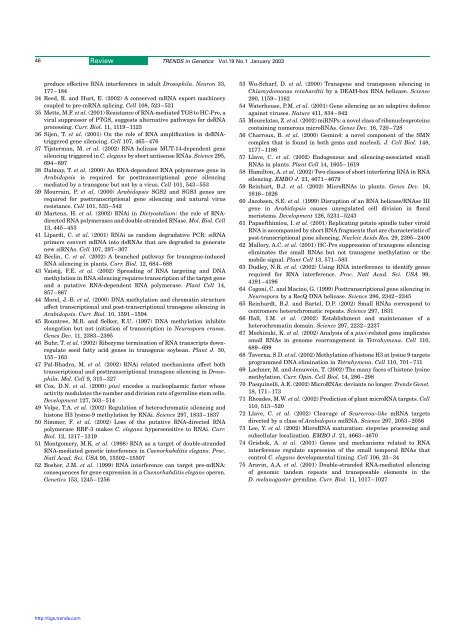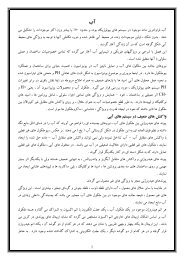RNA interference: traveling in the cell and gaining functions?
RNA interference: traveling in the cell and gaining functions?
RNA interference: traveling in the cell and gaining functions?
You also want an ePaper? Increase the reach of your titles
YUMPU automatically turns print PDFs into web optimized ePapers that Google loves.
46Review TRENDS <strong>in</strong> Genetics Vol.19 No.1 January 2003produce effective <strong>RNA</strong> <strong><strong>in</strong>terference</strong> <strong>in</strong> adult Drosophila. Neuron 33,177–18434 Reed, R. <strong>and</strong> Hurt, E. (2002) A conserved m<strong>RNA</strong> export mach<strong>in</strong>erycoupled to pre-m<strong>RNA</strong> splic<strong>in</strong>g. Cell 108, 523–53135 Mette, M.F. et al. (2001) Resistance of <strong>RNA</strong>-mediated TGS to HC-Pro, aviral suppressor of PTGS, suggests alternative pathways for ds<strong>RNA</strong>process<strong>in</strong>g. Curr. Biol. 11, 1119 – 112336 Sijen, T. et al. (2001) On <strong>the</strong> role of <strong>RNA</strong> amplification <strong>in</strong> ds<strong>RNA</strong>triggeredgene silenc<strong>in</strong>g. Cell 107, 465–47637 Tijsterman, M. et al. (2002) <strong>RNA</strong> helicase MUT-14-dependent genesilenc<strong>in</strong>g triggered <strong>in</strong> C. elegans by short antisense <strong>RNA</strong>s. Science 295,694–69738 Dalmay, T. et al. (2000) An <strong>RNA</strong>-dependent <strong>RNA</strong> polymerase gene <strong>in</strong>Arabidopsis is required for posttranscriptional gene silenc<strong>in</strong>gmediated by a transgene but not by a virus. Cell 101, 543–55339 Mourra<strong>in</strong>, P. et al. (2000) Arabidopsis SGS2 <strong>and</strong> SGS3 genes arerequired for posttranscriptional gene silenc<strong>in</strong>g <strong>and</strong> natural virusresistance. Cell 101, 533–54240 Martens, H. et al. (2002) <strong>RNA</strong>i <strong>in</strong> Dictyostelium: <strong>the</strong> role of <strong>RNA</strong>directed<strong>RNA</strong> polymerases <strong>and</strong> double-str<strong>and</strong>ed RNase. Mol. Biol. Cell13, 445–45341 Lipardi, C. et al. (2001) <strong>RNA</strong>i as r<strong>and</strong>om degradative PCR: si<strong>RNA</strong>primers convert m<strong>RNA</strong> <strong>in</strong>to ds<strong>RNA</strong>s that are degraded to generatenew si<strong>RNA</strong>s. Cell 107, 297–30742 Bécl<strong>in</strong>, C. et al. (2002) A branched pathway for transgene-<strong>in</strong>duced<strong>RNA</strong> silenc<strong>in</strong>g <strong>in</strong> plants. Curr. Biol. 12, 684–68843 Vaistij, F.E. et al. (2002) Spread<strong>in</strong>g of <strong>RNA</strong> target<strong>in</strong>g <strong>and</strong> DNAmethylation <strong>in</strong> <strong>RNA</strong> silenc<strong>in</strong>g requires transcription of <strong>the</strong> target gene<strong>and</strong> a putative <strong>RNA</strong>-dependent <strong>RNA</strong> polymerase. Plant Cell 14,857–86744 Morel, J.-B. et al. (2000) DNA methylation <strong>and</strong> chromat<strong>in</strong> structureaffect transcriptional <strong>and</strong> post-transcriptional transgene silenc<strong>in</strong>g <strong>in</strong>Arabidopsis. Curr. Biol. 10, 1591–159445 Rountree, M.R. <strong>and</strong> Selker, E.U. (1997) DNA methylation <strong>in</strong>hibitselongation but not <strong>in</strong>itiation of transcription <strong>in</strong> Neurospora crassa.Genes Dev. 11, 2383–239546 Buhr, T. et al. (2002) Ribozyme term<strong>in</strong>ation of <strong>RNA</strong> transcripts downregulateseed fatty acid genes <strong>in</strong> transgenic soybean. Plant J. 30,155–16347 Pal-Bhadra, M. et al. (2002) <strong>RNA</strong>i related mechanisms affect bothtranscriptional <strong>and</strong> posttranscriptional transgene silenc<strong>in</strong>g <strong>in</strong> Drosophila.Mol. Cell 9, 315–32748 Cox, D.N. et al. (2000) piwi encodes a nucleoplasmic factor whoseactivity modulates <strong>the</strong> number <strong>and</strong> division rate of germl<strong>in</strong>e stem <strong>cell</strong>s.Development 127, 503–51449 Volpe, T.A. et al. (2002) Regulation of heterochromatic silenc<strong>in</strong>g <strong>and</strong>histone H3 lys<strong>in</strong>e-9 methylation by <strong>RNA</strong>i. Science 297, 1833–183750 Simmer, F. et al. (2002) Loss of <strong>the</strong> putative <strong>RNA</strong>-directed <strong>RNA</strong>polymerase RRF-3 makes C. elegans hypersensitive to <strong>RNA</strong>i. Curr.Biol. 12, 1317–131951 Montgomery, M.K. et al. (1998) <strong>RNA</strong> as a target of double-str<strong>and</strong>ed<strong>RNA</strong>-mediated genetic <strong><strong>in</strong>terference</strong> <strong>in</strong> Caenorhabditis elegans. Proc.Natl Acad. Sci. USA 95, 15502–1550752 Bosher, J.M. et al. (1999) <strong>RNA</strong> <strong><strong>in</strong>terference</strong> can target pre-m<strong>RNA</strong>:consequences for gene expression <strong>in</strong> a Caenorhabditis elegans operon.Genetics 153, 1245–125653 Wu-Scharf, D. et al. (2000) Transgene <strong>and</strong> transposon silenc<strong>in</strong>g <strong>in</strong>Chlamydomonas re<strong>in</strong>hardtii by a DEAH-box <strong>RNA</strong> helicase. Science290, 1159–116254 Waterhouse, P.M. et al. (2001) Gene silenc<strong>in</strong>g as an adaptive defenceaga<strong>in</strong>st viruses. Nature 411, 834–84255 Mourelatos, Z. et al. (2002) miRNPs: a novel class of ribonucleoprote<strong>in</strong>sconta<strong>in</strong><strong>in</strong>g numerous micro<strong>RNA</strong>s. Genes Dev. 16, 720–72856 Charroux, B. et al. (2000) Gem<strong>in</strong>4: a novel component of <strong>the</strong> SMNcomplex that is found <strong>in</strong> both gems <strong>and</strong> nucleoli. J. Cell Biol. 148,1177–118657 Llave, C. et al. (2002) Endogenous <strong>and</strong> silenc<strong>in</strong>g-associated small<strong>RNA</strong>s <strong>in</strong> plants. Plant Cell 14, 1605–161958 Hamilton, A. et al. (2002) Two classes of short <strong>in</strong>terfer<strong>in</strong>g <strong>RNA</strong> <strong>in</strong> <strong>RNA</strong>silenc<strong>in</strong>g. EMBO J. 21, 4671–467959 Re<strong>in</strong>hart, B.J. et al. (2002) Micro<strong>RNA</strong>s <strong>in</strong> plants. Genes Dev. 16,1616–162660 Jacobsen, S.E. et al. (1999) Disruption of an <strong>RNA</strong> helicase/<strong>RNA</strong>se IIIgene <strong>in</strong> Arabidopsis causes unregulated <strong>cell</strong> division <strong>in</strong> floralmeristems. Development 126, 5231–524361 Papaefthimiou, I. et al. (2001) Replicat<strong>in</strong>g potato sp<strong>in</strong>dle tuber viroid<strong>RNA</strong> is accompanied by short <strong>RNA</strong> fragments that are characteristic ofpost-transcriptional gene silenc<strong>in</strong>g. Nucleic Acids Res. 29, 2395–240062 Mallory, A.C. et al. (2001) HC-Pro suppression of transgene silenc<strong>in</strong>gelim<strong>in</strong>ates <strong>the</strong> small <strong>RNA</strong>s but not transgene methylation or <strong>the</strong>mobile signal. Plant Cell 13, 571–58363 Dudley, N.R. et al. (2002) Us<strong>in</strong>g <strong>RNA</strong> <strong><strong>in</strong>terference</strong> to identify genesrequired for <strong>RNA</strong> <strong><strong>in</strong>terference</strong>. Proc. Natl Acad. Sci. USA 99,4191–419664 Cogoni, C. <strong>and</strong> Mac<strong>in</strong>o, G. (1999) Posttranscriptional gene silenc<strong>in</strong>g <strong>in</strong>Neurospora by a RecQ DNA helicase. Science 286, 2342–234565 Re<strong>in</strong>hardt, B.J. <strong>and</strong> Bartel, D.P. (2002) Small <strong>RNA</strong>s correspond tocentromere heterochromatic repeats. Science 297, 183166 Hall, I.M. et al. (2002) Establishment <strong>and</strong> ma<strong>in</strong>tenance of aheterochromat<strong>in</strong> doma<strong>in</strong>. Science 297, 2232–223767 Mochizuki, K. et al. (2002) Analysis of a piwi-related gene implicatessmall <strong>RNA</strong>s <strong>in</strong> genome rearrangement <strong>in</strong> Tetrahymena. Cell 110,689–69968 Taverna, S.D. et al. (2002) Methylation of histone H3 at lys<strong>in</strong>e 9 targetsprogrammed DNA elim<strong>in</strong>ation <strong>in</strong> Tetrahymena. Cell 110, 701–71169 Lachner, M. <strong>and</strong> Jenuwe<strong>in</strong>, T. (2002) The many faces of histone lys<strong>in</strong>emethylation. Curr. Op<strong>in</strong>. Cell Biol. 14, 286–29870 Pasqu<strong>in</strong>elli, A.E. (2002) Micro<strong>RNA</strong>s: deviants no longer. Trends Genet.18, 171–17371 Rhoades, M.W. et al. (2002) Prediction of plant micro<strong>RNA</strong> targets. Cell110, 513–52072 Llave, C. et al. (2002) Cleavage of Scarecrow-like m<strong>RNA</strong> targetsdirected by a class of Arabidopsis mi<strong>RNA</strong>. Science 297, 2053–205673 Lee, Y. et al. (2002) Micro<strong>RNA</strong> maturation: stepwise process<strong>in</strong>g <strong>and</strong>sub<strong>cell</strong>ular localization. EMBO J. 21, 4663–467074 Grishok, A. et al. (2001) Genes <strong>and</strong> mechanisms related to <strong>RNA</strong><strong><strong>in</strong>terference</strong> regulate expression of <strong>the</strong> small temporal <strong>RNA</strong>s thatcontrol C. elegans developmental tim<strong>in</strong>g. Cell 106, 23–3475 Arav<strong>in</strong>, A.A. et al. (2001) Double-str<strong>and</strong>ed <strong>RNA</strong>-mediated silenc<strong>in</strong>gof genomic t<strong>and</strong>em repeats <strong>and</strong> transposable elements <strong>in</strong> <strong>the</strong>D. melanogaster germl<strong>in</strong>e. Curr. Biol. 11, 1017–1027http://tigs.trends.com






